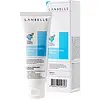What's inside
What's inside
 Key Ingredients
Key Ingredients

 Benefits
Benefits

 Concerns
Concerns

 Ingredients Side-by-side
Ingredients Side-by-side

Water
Skin ConditioningHydrogenated Polyisobutene
EmollientDimethicone 1%
EmollientGlycerin
HumectantButyrospermum Parkii Butter
Skin ConditioningPanthenol
Skin ConditioningAluminum Starch Octenylsuccinate
AbsorbentButylene Glycol
HumectantPropanediol
SolventCetyl PEG/PPG-10/1 Dimethicone
EmulsifyingTrihydroxystearin
Skin ConditioningZinc Gluconate
Skin ConditioningMadecassoside
AntioxidantManganese Gluconate
Skin ConditioningSilica
AbrasiveAluminum Hydroxide
EmollientMagnesium Sulfate
Disodium EDTA
Copper Gluconate
Skin ConditioningCitric Acid
BufferingAcetylated Glycol Stearate
EmollientPolyglyceryl-4 Isostearate
EmulsifyingTocopherol
AntioxidantPentaerythrityl Tetra-Di-T-Butyl Hydroxyhydrocinnamate
AntioxidantSodium Benzoate
MaskingPhenoxyethanol
PreservativeChlorhexidine Digluconate
AntimicrobialTitanium Dioxide
Cosmetic ColorantWater, Hydrogenated Polyisobutene, Dimethicone 1%, Glycerin, Butyrospermum Parkii Butter, Panthenol, Aluminum Starch Octenylsuccinate, Butylene Glycol, Propanediol, Cetyl PEG/PPG-10/1 Dimethicone, Trihydroxystearin, Zinc Gluconate, Madecassoside, Manganese Gluconate, Silica, Aluminum Hydroxide, Magnesium Sulfate, Disodium EDTA, Copper Gluconate, Citric Acid, Acetylated Glycol Stearate, Polyglyceryl-4 Isostearate, Tocopherol, Pentaerythrityl Tetra-Di-T-Butyl Hydroxyhydrocinnamate, Sodium Benzoate, Phenoxyethanol, Chlorhexidine Digluconate, Titanium Dioxide
Bambusa Vulgaris Water
Skin ConditioningWater
Skin ConditioningGlycerin
HumectantPersea Gratissima Oil
Skin ConditioningSqualane
EmollientHydrogenated Poly(C6-14 Olefin)
EmollientDipropylene Glycol
HumectantCetyl Ethylhexanoate
EmollientCetearyl Alcohol
Emollient1,2-Hexanediol
Skin ConditioningHydrogenated Vegetable Oil
EmollientGlyceryl Stearate
EmollientCeresin
Emulsion StabilisingDioscorea Japonica Root Extract
Skin ConditioningMadecassoside
AntioxidantCopper Tripeptide-1
Skin ConditioningAllantoin
Skin ConditioningPanthenol
Skin ConditioningThymus Vulgaris Extract
PerfumingRosmarinus Officinalis Extract
AntimicrobialOriganum Vulgare Flower/Leaf/Stem Extract
Skin ConditioningLavandula Angustifolia Extract
Skin ConditioningStearic Acid
CleansingCetearyl Olivate
Butylene Glycol
HumectantC12-16 Alcohols
EmollientIsododecane
EmollientSorbitan Olivate
EmulsifyingAmmonium Acryloyldimethyltaurate/Vp Copolymer
Palmitic Acid
EmollientHydrogenated Lecithin
EmulsifyingCetearyl Glucoside
EmulsifyingDimethiconol
EmollientDimethicone/Vinyl Dimethicone Crosspolymer
Skin ConditioningZanthoxylum Piperitum Fruit Extract
Skin ConditioningLonicera Japonica Flower Extract
Skin ConditioningPulsatilla Koreana Extract
Skin ConditioningCitrus Paradisi Fruit Extract
Skin ConditioningCitrus Aurantium Bergamia Fruit Oil
MaskingGlycine
BufferingGlucose
HumectantDisodium EDTA
Bambusa Vulgaris Water, Water, Glycerin, Persea Gratissima Oil, Squalane, Hydrogenated Poly(C6-14 Olefin), Dipropylene Glycol, Cetyl Ethylhexanoate, Cetearyl Alcohol, 1,2-Hexanediol, Hydrogenated Vegetable Oil, Glyceryl Stearate, Ceresin, Dioscorea Japonica Root Extract, Madecassoside, Copper Tripeptide-1, Allantoin, Panthenol, Thymus Vulgaris Extract, Rosmarinus Officinalis Extract, Origanum Vulgare Flower/Leaf/Stem Extract, Lavandula Angustifolia Extract, Stearic Acid, Cetearyl Olivate, Butylene Glycol, C12-16 Alcohols, Isododecane, Sorbitan Olivate, Ammonium Acryloyldimethyltaurate/Vp Copolymer, Palmitic Acid, Hydrogenated Lecithin, Cetearyl Glucoside, Dimethiconol, Dimethicone/Vinyl Dimethicone Crosspolymer, Zanthoxylum Piperitum Fruit Extract, Lonicera Japonica Flower Extract, Pulsatilla Koreana Extract, Citrus Paradisi Fruit Extract, Citrus Aurantium Bergamia Fruit Oil, Glycine, Glucose, Disodium EDTA
 Reviews
Reviews

Alternatives
Ingredients Explained
These ingredients are found in both products.
Ingredients higher up in an ingredient list are typically present in a larger amount.
Butylene Glycol (or BG) is used within cosmetic products for a few different reasons:
Overall, Butylene Glycol is a safe and well-rounded ingredient that works well with other ingredients.
Though this ingredient works well with most skin types, some people with sensitive skin may experience a reaction such as allergic rashes, closed comedones, or itchiness.
Learn more about Butylene GlycolDisodium EDTA plays a role in making products more stable by aiding other preservatives.
It is a chelating agent, meaning it neutralizes metal ions that may be found in a product.
Disodium EDTA is a salt of edetic acid and is found to be safe in cosmetic ingredients.
Learn more about Disodium EDTAGlycerin is already naturally found in your skin. It helps moisturize and protect your skin.
A study from 2016 found glycerin to be more effective as a humectant than AHAs and hyaluronic acid.
As a humectant, it helps the skin stay hydrated by pulling moisture to your skin. The low molecular weight of glycerin allows it to pull moisture into the deeper layers of your skin.
Hydrated skin improves your skin barrier; Your skin barrier helps protect against irritants and bacteria.
Glycerin has also been found to have antimicrobial and antiviral properties. Due to these properties, glycerin is often used in wound and burn treatments.
In cosmetics, glycerin is usually derived from plants such as soybean or palm. However, it can also be sourced from animals, such as tallow or animal fat.
This ingredient is organic, colorless, odorless, and non-toxic.
Glycerin is the name for this ingredient in American English. British English uses Glycerol/Glycerine.
Learn more about GlycerinMadecassoside comes from the super popular skin-soothing ingredient, Centella asiatica. It is one of four active compounds found in the extract of Centella Asiatica.
Madecassoside has antioxidant, anti-inflammatory, and hydrating properties. It contains fatty acids, amino acids, beta-carotene, and phytochemicals.
One study found using Madecassoside with ascorbic acid helped reduce the signs of aging and improved skin hydration.
Learn more about MadecassosidePanthenol is a common ingredient that helps hydrate and soothe the skin. It is found naturally in our skin and hair.
There are two forms of panthenol: D and L.
D-panthenol is also known as dexpanthenol. Most cosmetics use dexpanthenol or a mixture of D and L-panthenol.
Panthenol is famous due to its ability to go deeper into the skin's layers. Using this ingredient has numerous pros (and no cons):
Like hyaluronic acid, panthenol is a humectant. Humectants are able to bind and hold large amounts of water to keep skin hydrated.
This ingredient works well for wound healing. It works by increasing tissue in the wound and helps close open wounds.
Once oxidized, panthenol converts to pantothenic acid. Panthothenic acid is found in all living cells.
This ingredient is also referred to as pro-vitamin B5.
Learn more about PanthenolWater. It's the most common cosmetic ingredient of all. You'll usually see it at the top of ingredient lists, meaning that it makes up the largest part of the product.
So why is it so popular? Water most often acts as a solvent - this means that it helps dissolve other ingredients into the formulation.
You'll also recognize water as that liquid we all need to stay alive. If you see this, drink a glass of water. Stay hydrated!
Learn more about Water